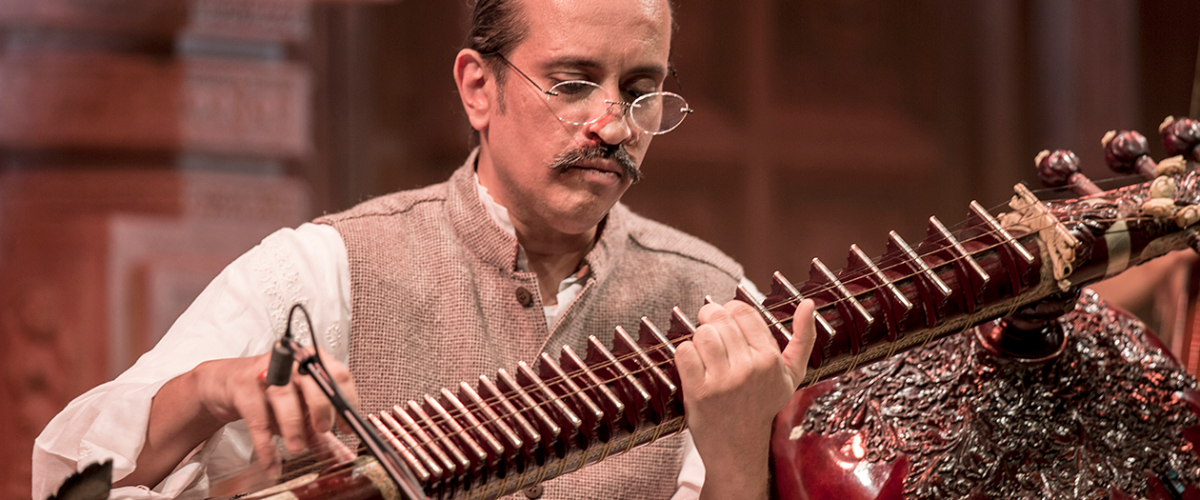

The word ‘Dhrupad’ is derived from ‘dhruva,’ meaning that which is ‘fixed’ or ‘constant’ and ‘pada', meaning ‘word’ or ‘set-composition’. It is the oldest form of North Indian classical vocal music, with origins lying in the antiquated chanting style of a sacred Sanskrit text known as the Samaveda, dating back to at least 3,000 years ago. A contemplative and meditative form of classical singing, the continuity of dhrupad in the modern age owes its existence to sustained worship rituals that have changed little over the centuries.
This music belonged in Hindu temples and also found a home in the royal courts of both Muslim and Hindu rulers where, and whilst retaining its sacred essence of Vedic chants and mantras, it began to evolve as a sophisticated art form with a complex musical grammar of its own. The best-known performers of this genre, the 'Senior' Dagar Brothers, also took to performing it with two main voices - although the form may not, strictly speaking, be considered a duet.
A central concept in dhrupad singing is the practice of nada yoga – exercises pertaining to an awareness of one’s own inner sounds and vibrations, and of understanding how these sounds and vibrations being the fundamental building blocks of the whole universe. Performers develop an enormous inner resonance of their bodies, so that sound appears to flow freely from the navel to the head, enabling a vast palette of tones and sruti (microtones) to be voiced seemingly effortlessly.
A dhrupad recital is typically divided into two main parts: starting with alap (slow, pulse-free introduction) which is the major part of the performance and which is usually sung using sounds and syllables rather than words (including stylised syllables such as ‘om,’ ‘nam,’ ‘re,’ ‘ri,’ ‘na,’ ‘ta,’ ‘nom,’ ‘tom’). The focus remains solely on the individual notes of the chosen raga (melodic structure) which is explored in depth, aiming to create an atmosphere that totally engulfs the audience in every shade and nuance of the particular character of that raga.
The alap begins in a low octave, the initial sounds barely audible, gradually rising on the musical scale with a corresponding rise in tempo. By the time this happens, the audience is so enveloped in the music and the tempo is increased in such small fractions that one is barely aware of its change of pace.
This is followed by the second section called dhrupad (the actual song composition), consisting of one or more set verses, always of a devotional nature and usually in Sanskrit or a form of medieval literary Hindi known as Braj Bhasha. The verses are delivered with clearly enunciated words and it is during this section that the singer is joined by a pakhawaj - an ancient, barrel-shaped drum with a deeply resonant sound.
Dhrupad’s popularity was in steady decline since around the beginning of the 18th century and the advent of khayal - another classical vocal form, generally considered to be more accessible. This decline also coincided with a significant shift in Indian musical thinking, whereby older forms which still retained their associations with devotional rituals were marginalised in preference to more 'entertaining' music. As a result, although dhrupad had all but disappeared from performance venues by the mid-20th century, owing to the ending of royal patronage (except for specific gatherings for a very few die-hards).
But in recent years dhrupad has returned with a vengeance – not only in India but also on the international stage – ever since the 1970s when musicologists such as Alain Daniélou started identifying it as a cultural tradition in danger of total eclipse. A spate of foreign recordings, notably in France and Japan, have led to a tremendous revival in this most ancient form of art music.
Listen to the music | Ustad Bahauddin Dagar’s rudra veena adds slow depth to Pelva Naik's superb vocals, live from Darbar's stage at the 2017 Ravenna Festival in Italy. Both musicians hail from the Dagarvani style of dhrupad, a 20-generation lineage.
Jameela Siddiqi is an author, linguist, and BBC cultural commentator, specialising in postcolonial fiction and the devotional music of South Asia.
Darbar believes in the power of Indian classical music to stir, thrill, and inspire. Explore our YouTube channel, or subscribe to the Darbar Concert Hall to watch extended festival performances, talk and documentaries in pristine HD and UHD quality.
Discover Indian classical music via styles you like - this article builds sonic bridges to rock, jazz, jungle,...
Read More 
It's like the rush of a marsh on a midsummer night with a million crickets, or the howling wind stirring and the...
Read More 
The rudra veena maestro discusses Dhrupad's curious modern context following his landmark solo performance at the...
Read More 
The beginner's guide to Indian classical music. Whether you’re completely new to raga music or just need a refresher, we’ve put together this brief overview of all things raga music to help you feel at ease when visiting one of our concerts or watch our videos on our YouTube or our Darbar Concert Hall.
Keep up to date with the latest news, events, music and musings across our social channels
For hundreds more clips and shorts, vist our YT page here 